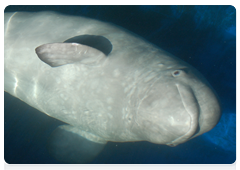MULTIMEDIA
 +
+
The white whale (also known as belukha whale) is a member of the Monodontidae family, suborder Odontoceti, and order Cetacea
 +
+
The Belukha-White Whale Programme aims to study the distribution range, seasonal migrations and the number of white whales in Russian seas and also, their habitat, feeding patterns and their relationships with other cetacean species
 +
+
Several species of large mammals that are seen as especially important and symbolic for Russia, in particular the white whale, have been chosen for research as part of the White Whale Programme
 +
+
The aerial survey programme helped researchers compile a large database of photo and video materials about the life of white whales
 +
+
Adult white whales can measure up to six metres and weigh up to two metric tonnes. White whale calves are grey, but at full maturity a few years later they become almost completely white
 +
+
In the White Sea, belukhas are noted for the vast span of their migrations, with only a small number of the mammals remaining in the same area throughout the year and the rest migrating to the Barents Sea and the Kara Sea in winter
 +
+
The belukha inhabits waters of different temperatures, ranging from freezing waters in winter to 32°C in summer
 +
+
Russian waters have three major groups of whales which some zoologists consider to be three different subspecies: namely those inhabiting the White Sea, the Kara Sea and the Far Eastern waters
 +
+
The belukha is one of the most numerous Arctic marine mammal species. They inhabit the coastal waters of the Arctic, as well as of the White Sea, the Barents Sea, the Bering Sea, and the Sea of Okhotsk
 +
+
The belukhas kept in zoos are trained with the use of special programs for interaction with veterinarians, scientific experiments, shows at aquariums and dolphin therapy
 +
+
Aquariums and zoos in Russia and elsewhere take about 20 belukhas annually. These animals should be healthy and well adapted to captivity
 +
+
The belukha whales feed mainly on fish, particularly schooling species such as cod, herring, plaice and salmon species, but they also eat shellfish and cuttlefish. An adult whale consumes near 15 kilograms of food daily
 +
+
White whales can be identified by photograph thanks to their scars. These scar patterns, unique to each whale, are easy to see on their white back, tail and sides
 +
+
White whales can be identified by photograph thanks to their scars. These scar patterns, unique to each whale, are easy to see on their white back, tail and sides
 +
+
White whales can be identified by photograph thanks to their scars. These scar patterns, unique to each whale, are easy to see on their white back, tail and sides
 +
+
White whales can be identified by photograph thanks to their scars. These scar patterns, unique to each whale, are easy to see on their white back, tail and sides
 +
+
White whales can be identified by photograph thanks to their scars. These scar patterns, unique to each whale, are easy to see on their white back, tail and sides
 +
+
White whales can be identified by photograph thanks to their scars. These scar patterns, unique to each whale, are easy to see on their white back, tail and sides
 +
+
White whales are cute, lovable animals. They are easy to train, which is why they often become the stars of sea-life centres and dolphinaria
 +
+
White whales are cute, lovable animals. They are easy to train, which is why they often become the stars of sea-life centres and dolphinaria
 +
+
Adult whales are also fond of jumping out of the water, but as a rule, do so only during the mating season
 +
+
The Solovetsky mating waters for beluga whales are unique in that the mammals swim very close to the shore and spend a long time here most days
 +
+
Beluga whales gather off Beluga Cape in May and spend the entire summer there, leaving around the end of September
 +
+
Beluga whales gather off Beluga Cape in May and spend the entire summer there, leaving around the end of September
 +
+
The Solovetsky mating waters for beluga whales are unique in that the mammals swim very close to the shore and spend a long time here most days















































 ABOUT THE PROGRAMME
ABOUT THE PROGRAMME
 WHITE WHALE: LIFE, BEHAVIOUR AND MORE
WHITE WHALE: LIFE, BEHAVIOUR AND MORE
 WHITE WHALE RESEARCH: A HISTORY
WHITE WHALE RESEARCH: A HISTORY
 VLADIMIR PUTIN'S VISIT
VLADIMIR PUTIN'S VISIT
 NEWS
NEWS
 MULTIMEDIA
MULTIMEDIA